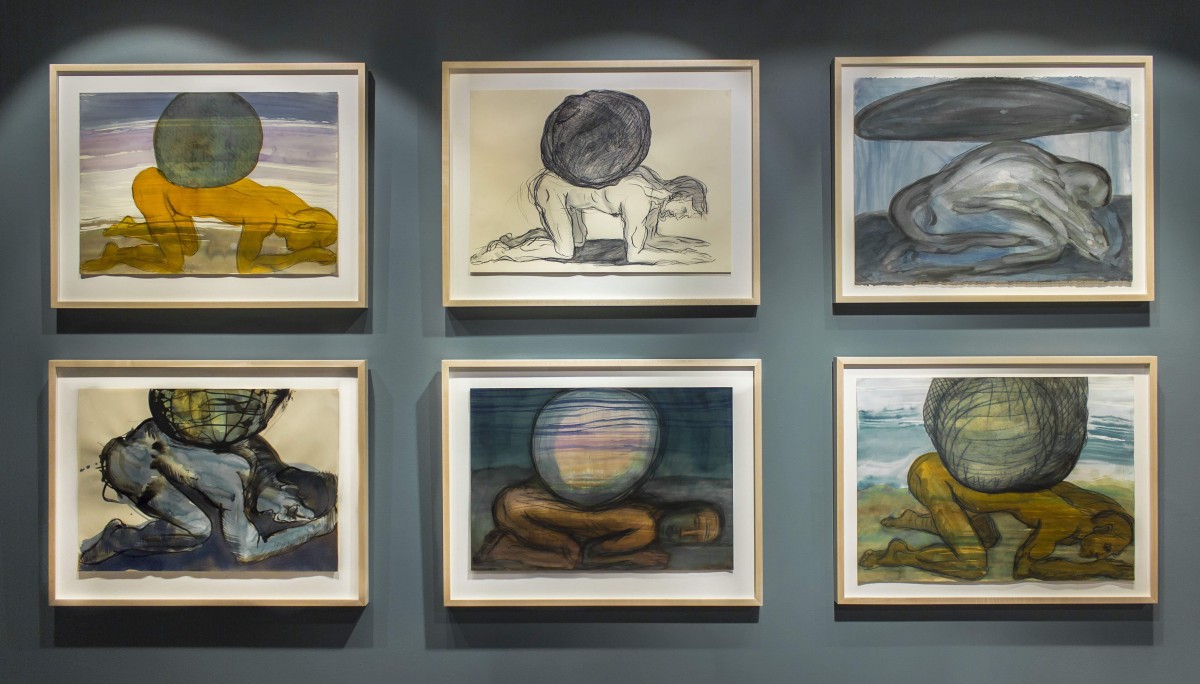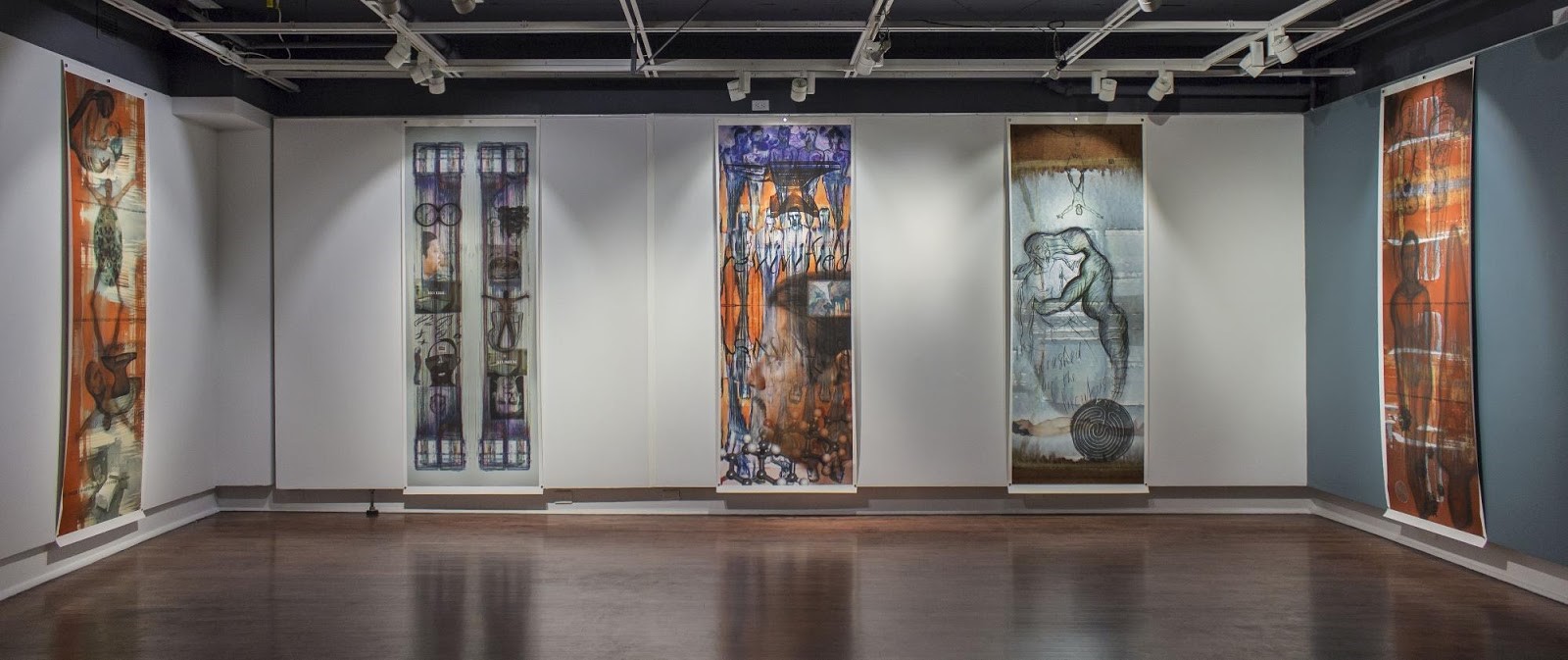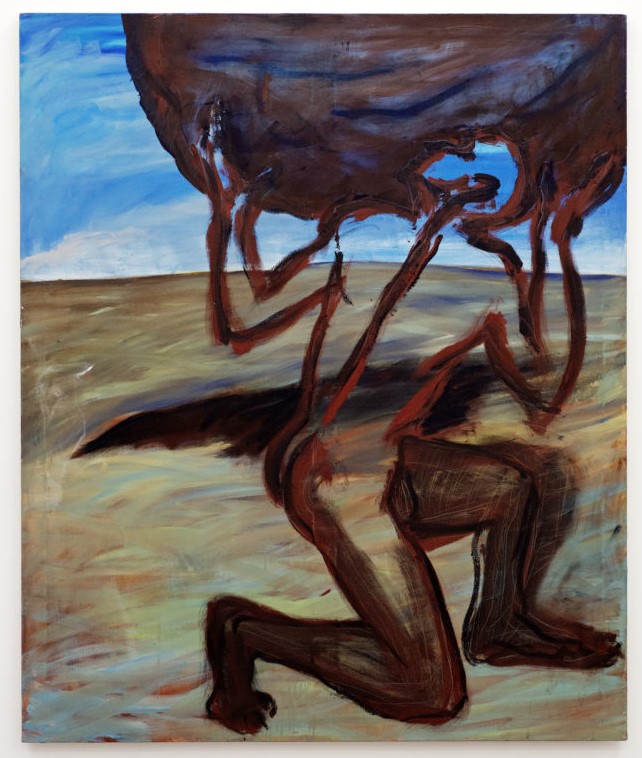Andy Fabo
Acclaimed artist, art critic, curator and art educator Andy Fabo conveys politics through allegorical drawings.
Andy Fabo, The Weight (2016-17) excerpts from series of 45 drawings. Dawson College installation 2020. ink, graphite, crayon, watercolour on paper. Photo credit: Sylvia Trotter-Ewens.
Acclaimed artist, art critic, independent curator and art educator Andy Fabo moved to Toronto in 1975. In 2005 he was given a retrospective at the Canadian Museum of Contemporary Canadian Art, an exhibition that featured his work over thirty years in a diverse range of media.
In the past decade he shifted the content of his work lately to create a digital painting & photographic series that documents art communities (Hamilton, North Bay) and the tangle of friendships within those communities. However a recent bout of AIDS-related pneumonia impelled him to revisit his activist work about the body in crisis and he created a drawing and large-scaled digital print exhibition titled Delirious on the Borderline for his 2013 MFA thesis exhibition at OCAD University. Since then he has concentrated on the medium of drawing making allegorical works about current political conditions.
"My work," says Fabo "has always been autobiographical, distilling my own experiences in order to describe the aspirations and hardships of everyday life. As a pioneer of gay-themed work in Canada in the 70s, I began by picturing desire in the face of the stricter norms of the time, forty years ago. This work also dealt with societal strictures on the body and reacted to the punitive policing of gay men in that era: bathhouse raids, bar raids, police harassment, surveillance & carding of gay men on the streets and in their gathering places. This autobiographical approach led me to also deal with the AIDS pandemic from the perspective of and HIV+ Queer man. In my art practice I have tried to mix an analytical, theoretical approach (often informed by the writing of Michel Foucault), with an elucidation of affect - the sensation of desire, adversity and resistance. "
AGO: What was the inspiration for this artwork or series?
Fabo: All three bodies of work tackle the theme of adversity. However, two images here are reflective of an attempt to talk about adversity in more general terms. Sisyphus on the Plains (1988) was painted after my partner Tim Jocelyn had died of AIDS. I created other bodies of work that deal more directly with the crisis of the last great pandemic but in this painting I hoped to create a broader notion of existential struggle that wasn't specific to AIDS. This intent reappears in the more recent drawing series The Weight in which I revisit the Sisyphus theme. The work was created during the anxious period that lead up to the election of Donald Trump. With American politics heavy on my mind as well as considerable worries about the ordeals of refugees both in the Mediterranean and at the US/Mexico border I created this series of 50 odd drawings - almost as a form of therapy.
The Delirum Scrolls are more personal and pointedly more biographical. After having been HIV+ for several decades, I contracted a fungal pneumonia that is usually only seen among the immunosuppressed and ended up in the hospital for three weeks. Using drawings created immediately after the experience that reflect the hallucinations from heavy doses of steroids, nude photos of myself as well as found photos of hospital rooms and pathogens, I used digital graphics to create these layered scrolls of my experience.
AGO: Tell us about a place or a space where you most love making your work?
Fabo: I share the dire situation of many Toronto artists, having lost my studio two years ago and not being able to find an affordable replacement. I love the solitude of a space of one's own that is totally dedicated to a creative practice. I envy post-studio artists who are able to do their work on a laptop but so many of my creative impulses involve messy materials and require more space than a desk. To remedy this, I have scaled down, working in miniature and have worked in collaboration with artists who still have spaces. I mention this, not to whine or complain, but to alert art audiences to the seriousness of the situation. I love Toronto and don't wish to move out of the city as so many artists had in the last decade.
AGO: Are you in dialogue with any other artists or creative peers about your practice? If so, how does this dialogue feed your work?
Fabo: Yes, I have a handful of smart talented friends who I trust to be honest when I am mid-series and need some feedback. Often when an artist finishes something that seems somewhat new in direction, he or she feels great insecurity about whether it is a worthwhile transition. Friends come to the rescue with hardnosed criticism. Also, artists need to discuss new issues, methods and evolving aesthetics to keep up with the dynamic nature of contemporary art.
Follow Andy @andy_fabo



